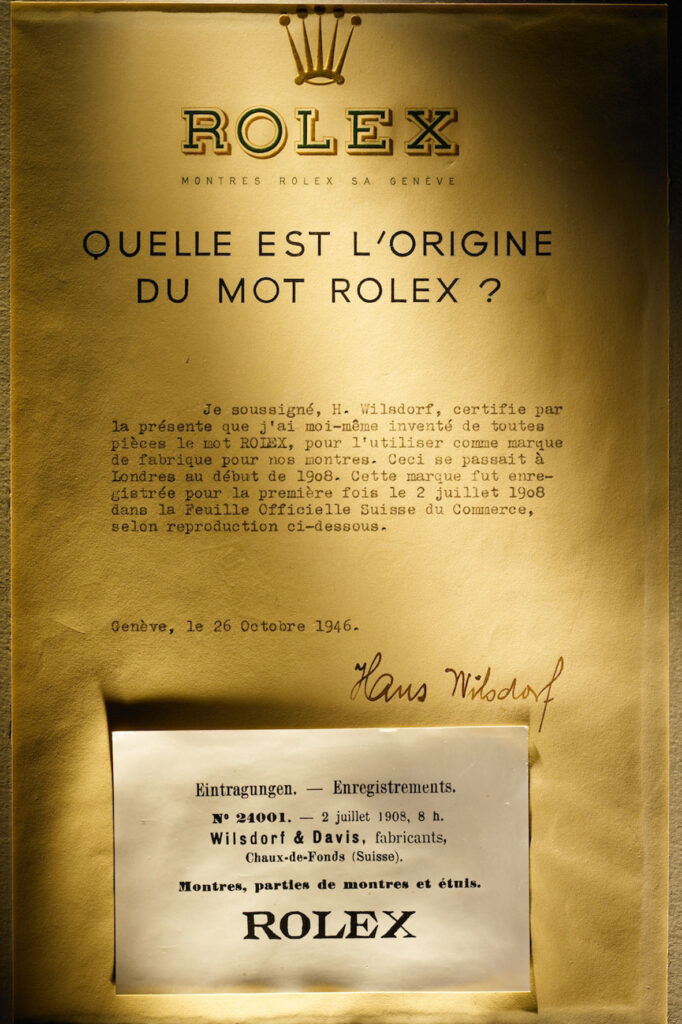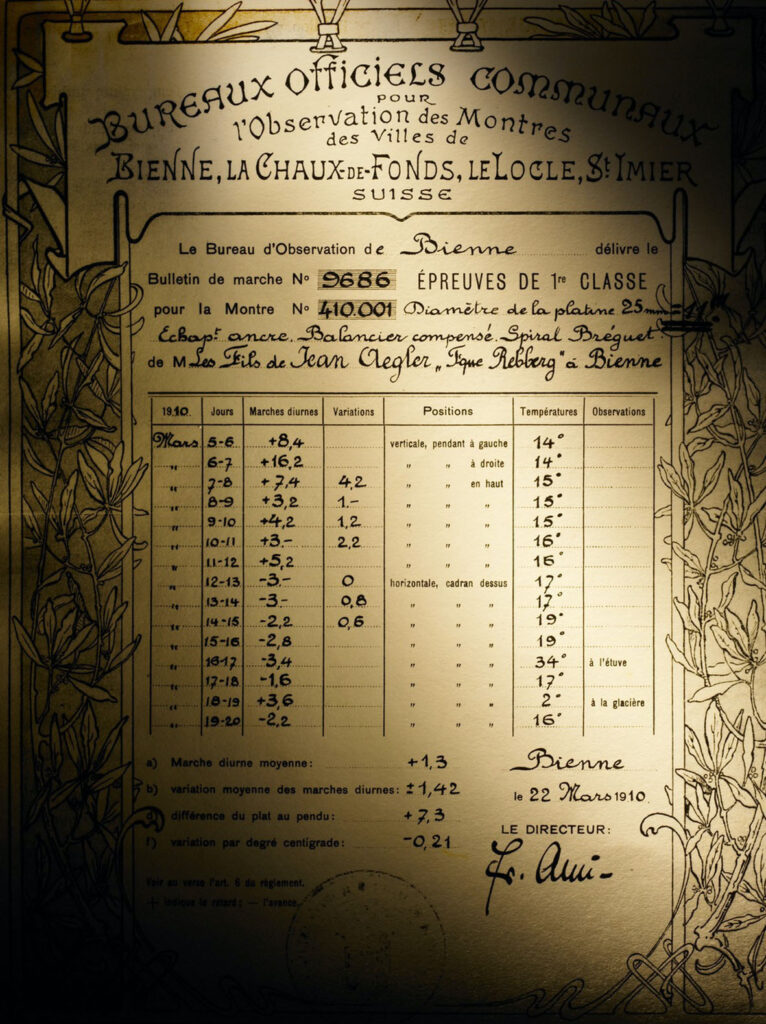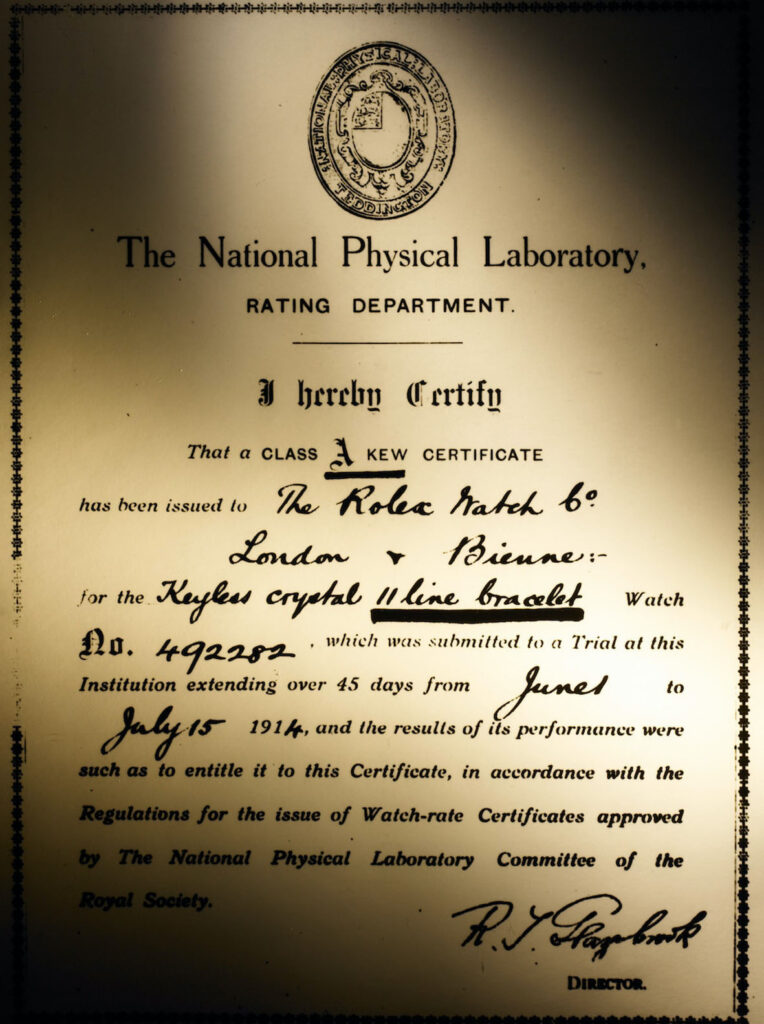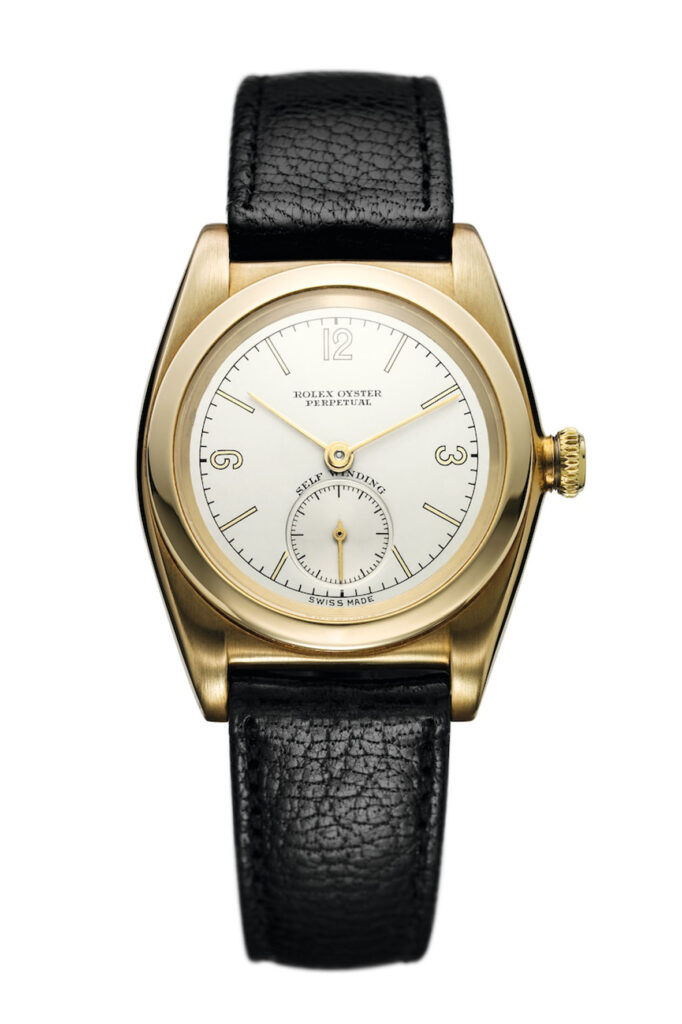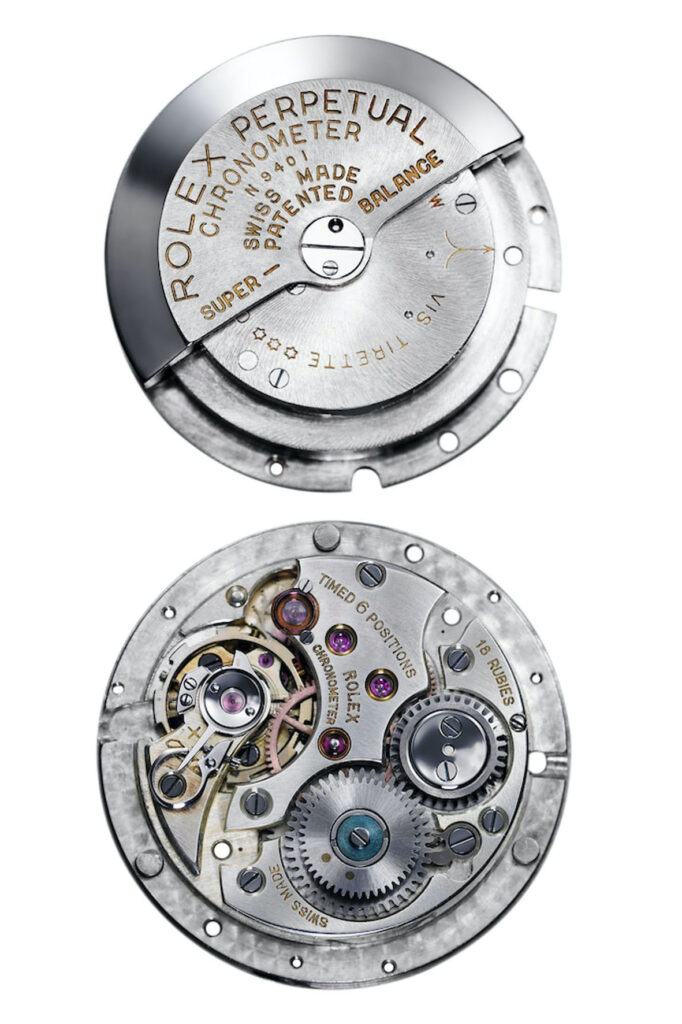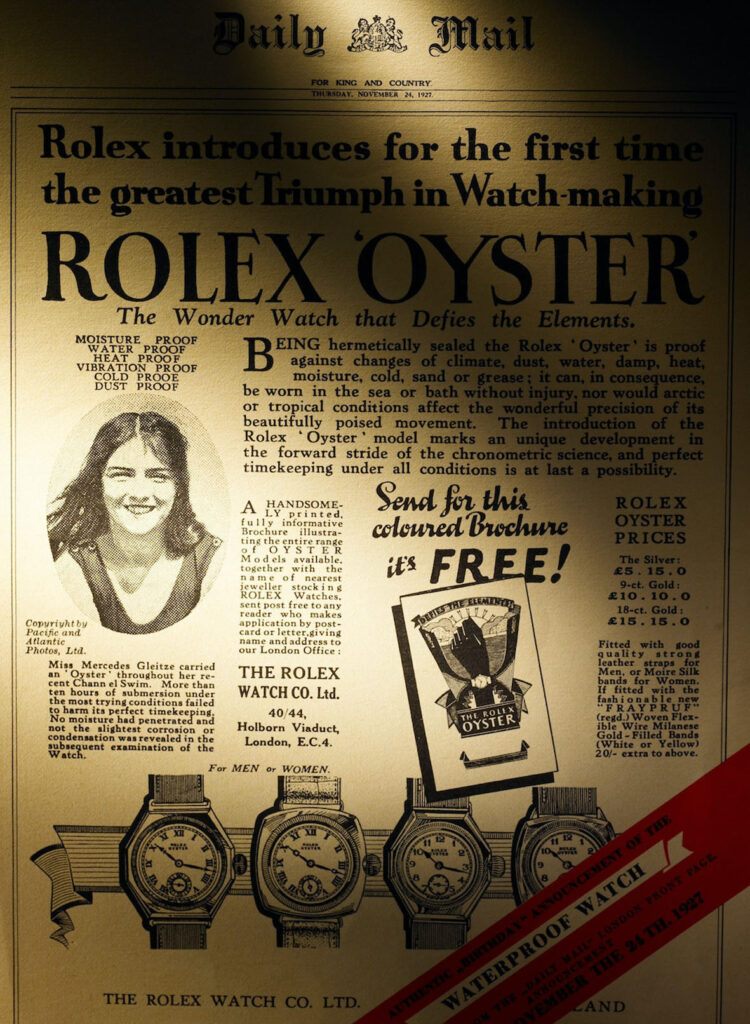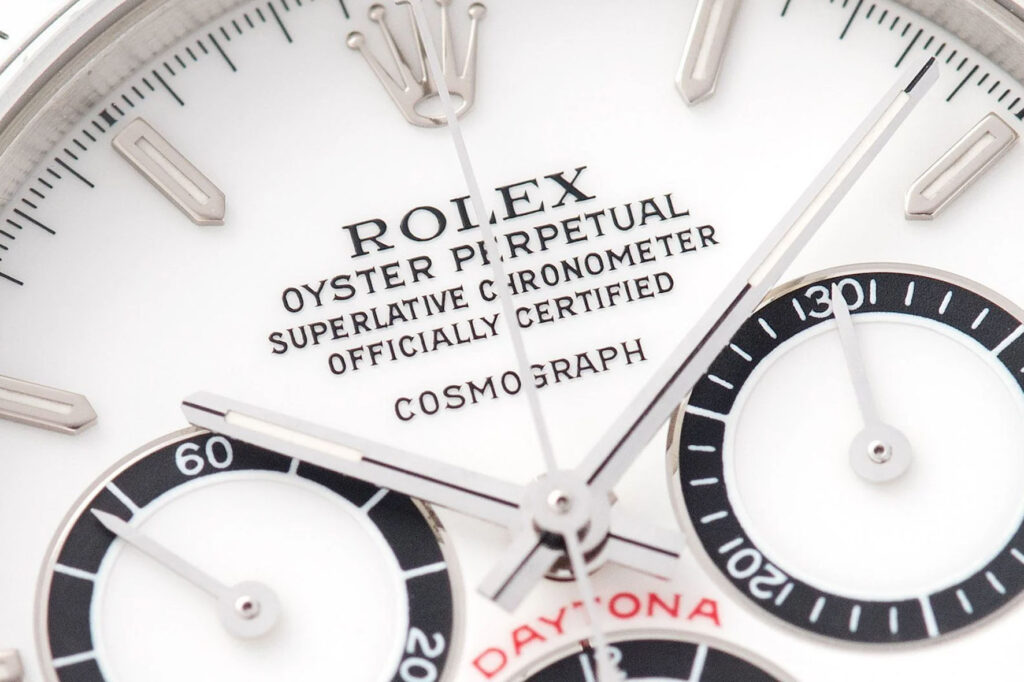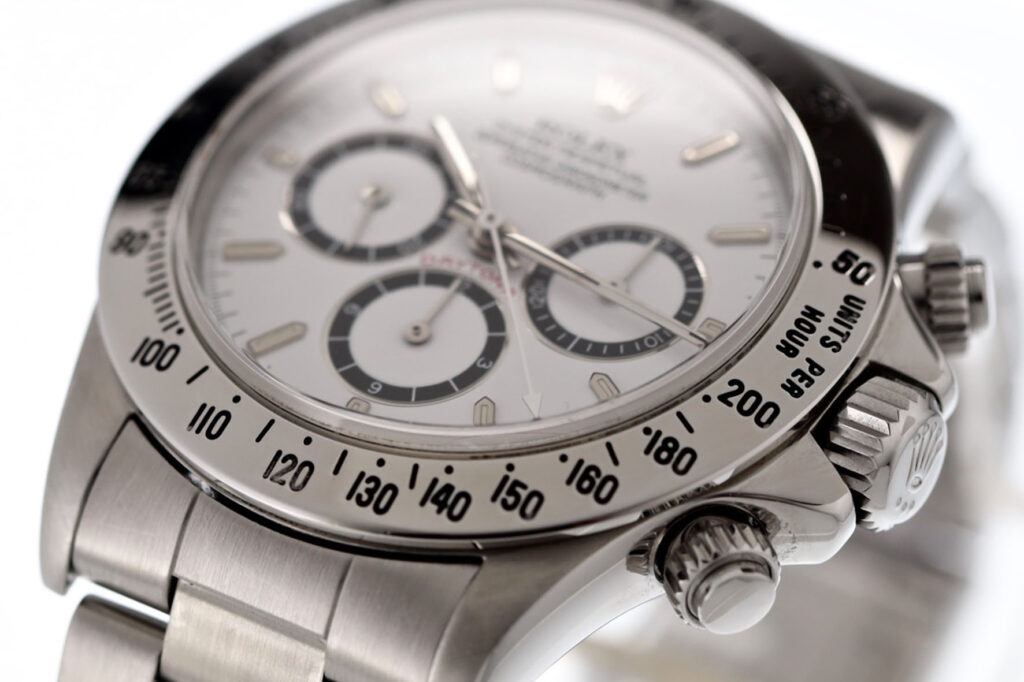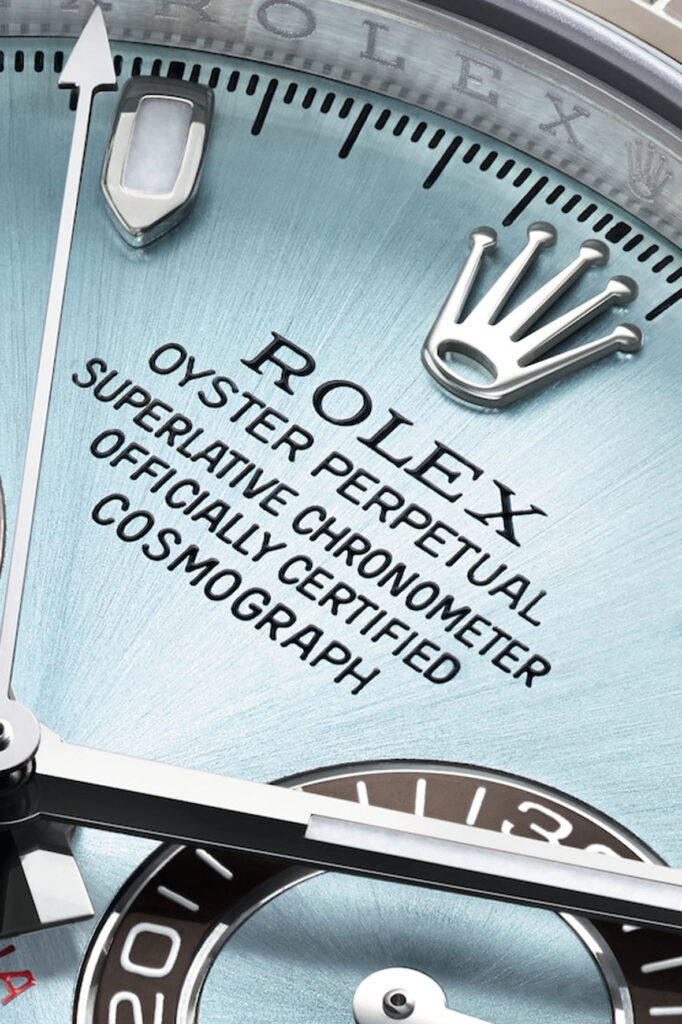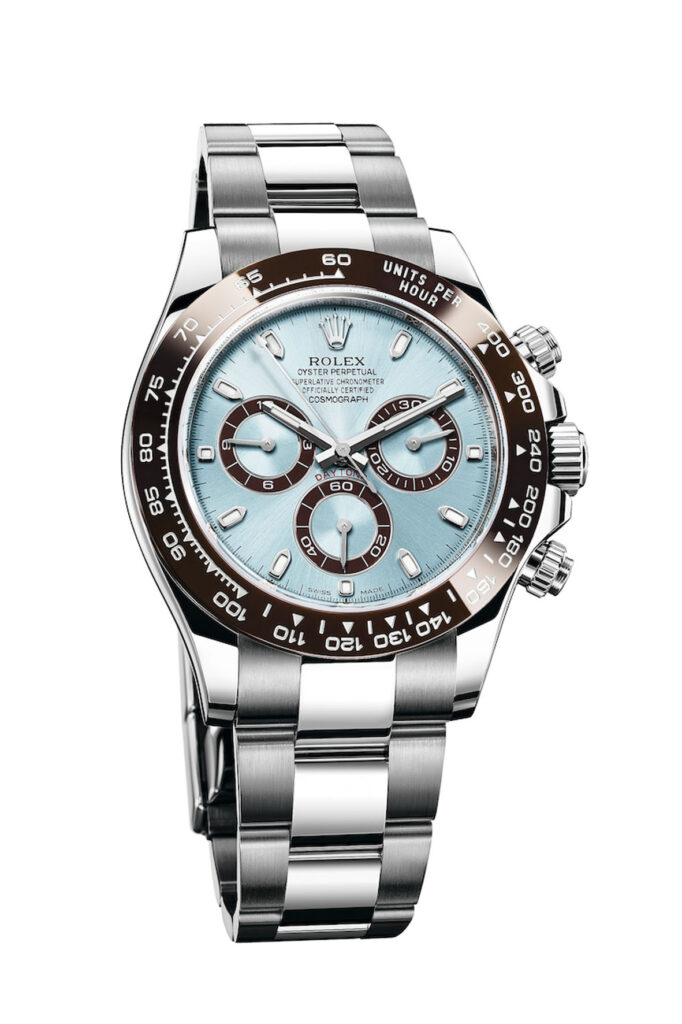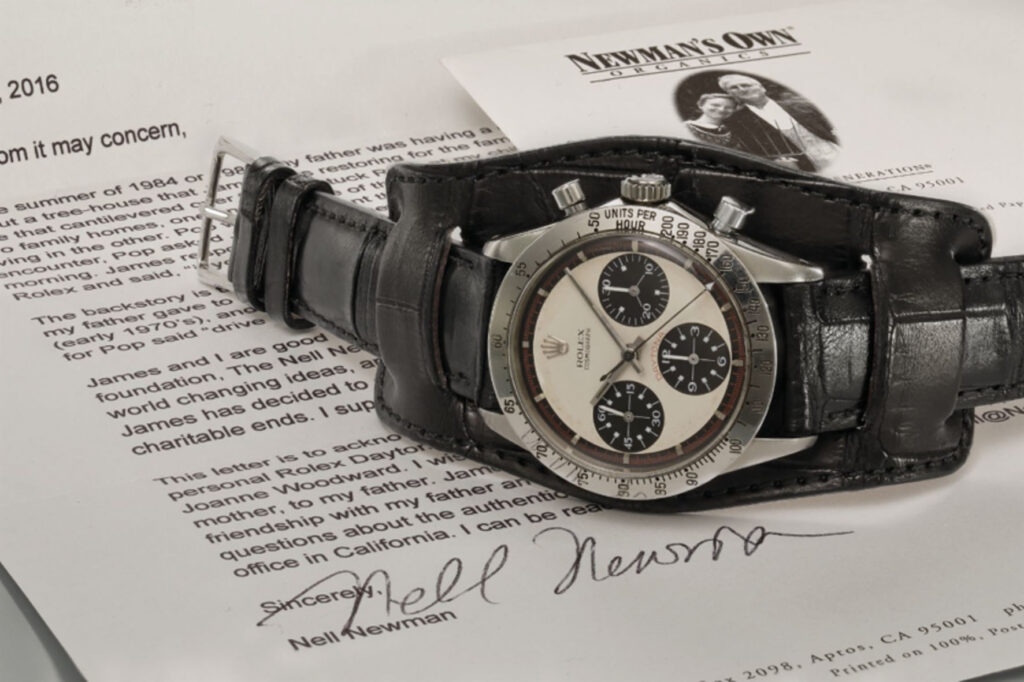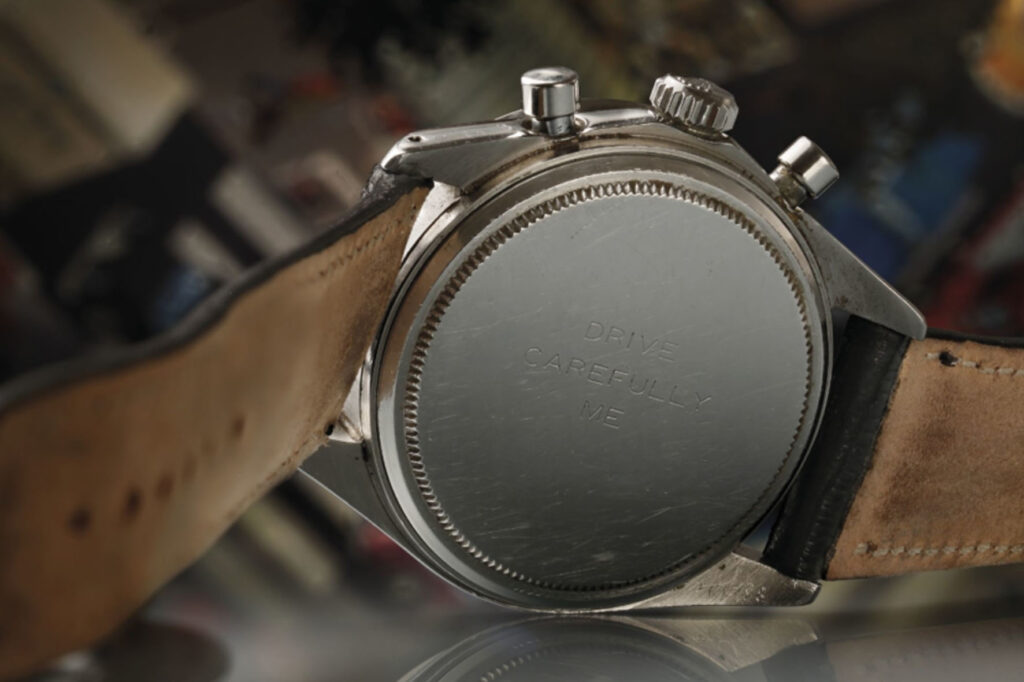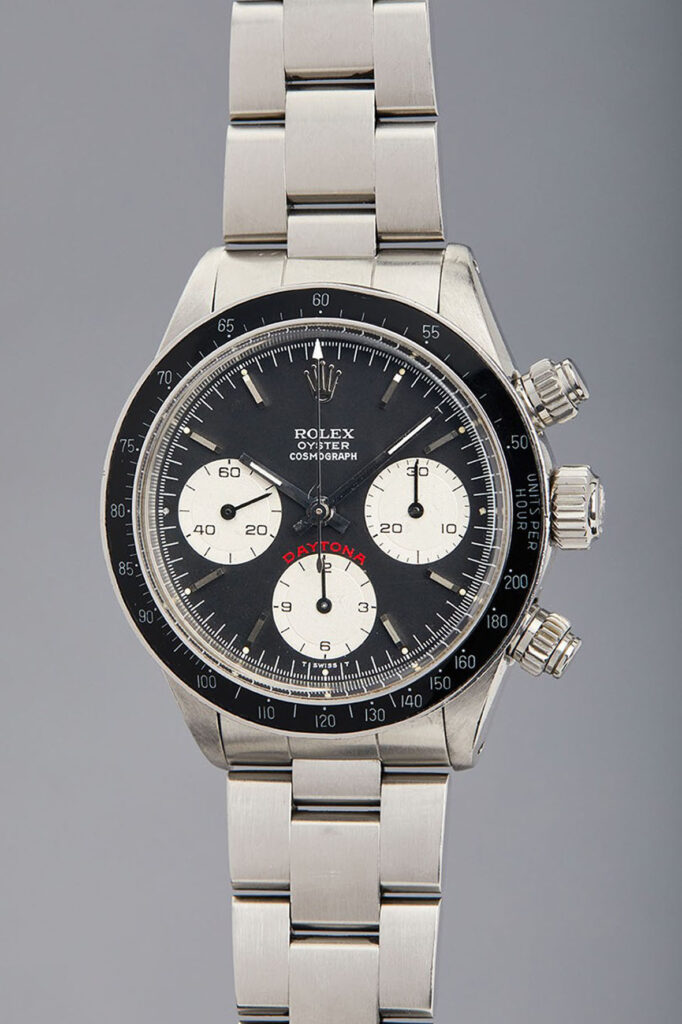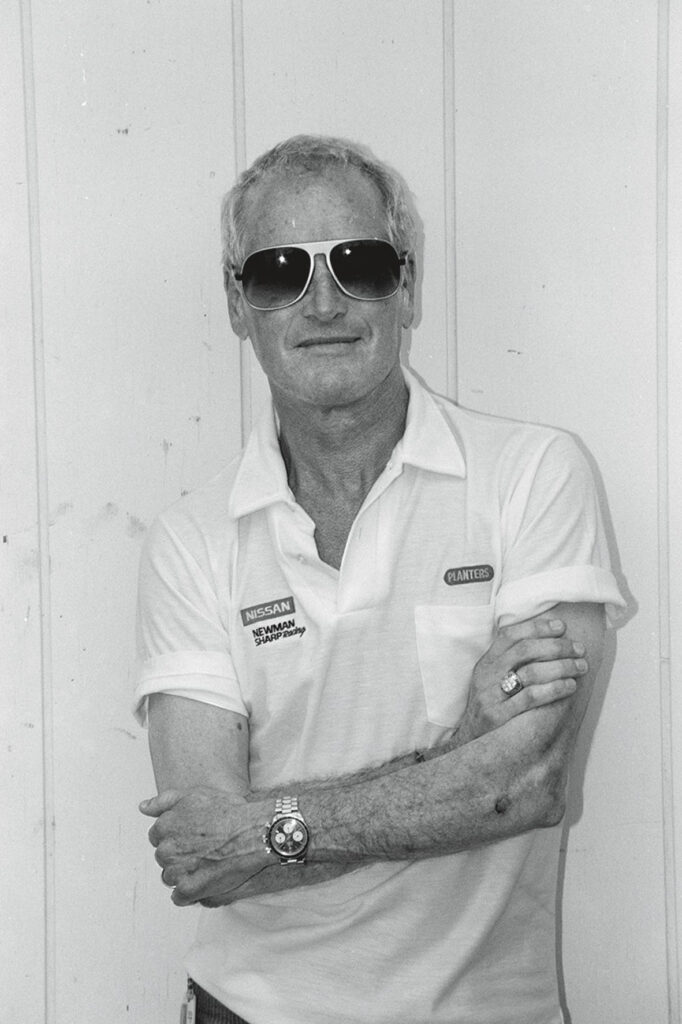Rolex Daytona: A 60-year legend
20 February 2023It is no coincidence that Rolex has uninterruptedly held the first place in the ranking evaluating the global brands reputation from 2016-2019, to then regain the primacy in 2022. The company’s success, not only among enthusiasts, is not only the result of the products quality but also of a story that in less than a century has become a myth. The watches are just as legendary, starting with the Daytona, which in 2023 turns 60, and whose evolution we want to narrate today. Not before having briefly retraced the main stages in Rolex history, recalling their watches.
A SHORT HISTORY OF ROLEX
Founded in Geneva in 1920 by Hans Wildorf, Montres Rolex S.A. actually has more distant origins. Wilsdorf, born in Bavaria in 1881, moved in the early 1900s to Switzerland, to La Chaux-de-Fonds, approaching the world of watchmaking. At a time when only pocket watches were used, he noticed the growing interest in wristwatches and realized the potential success of their diffusion, even if they were primarily considered female jewellery.
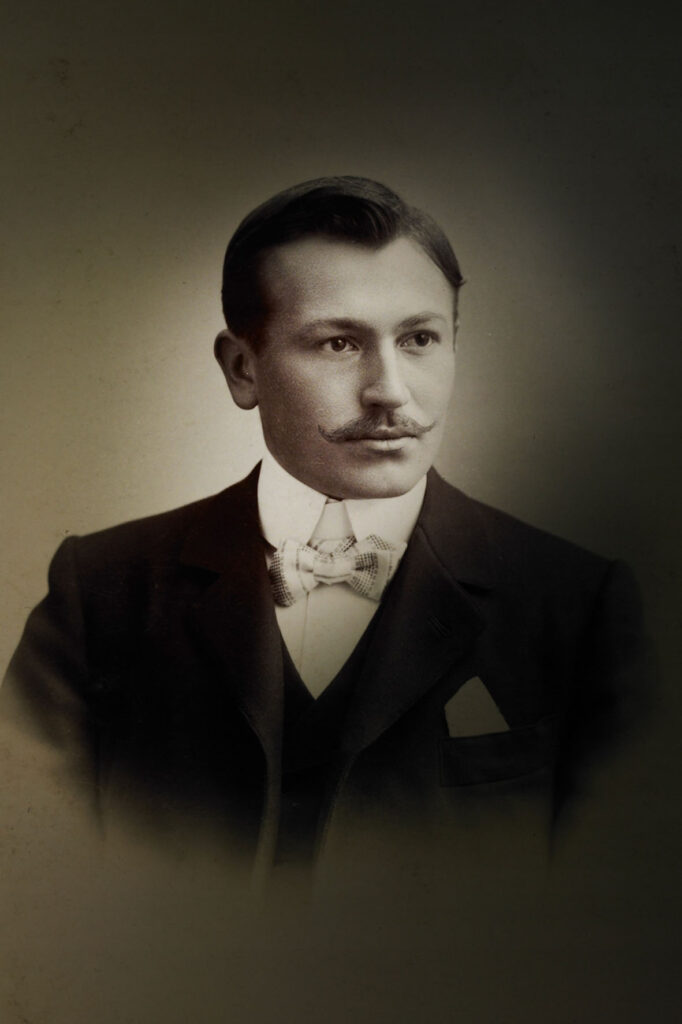
La Chaux-de-Fonds soon became too narrow for Wilsdorf’s vision, who then moved to London where he founded in 1905, together with a partner, Wilsdorf & Davis: a company specializing in marketing of wristwatches in Great Britain and in the British Empire. The components were produced by Swiss partners selected for their expertise; among them was the Maison Aegler in Bienne, the only one at the time – according to Wilsdorf – capable of manufacturing small but precise movements. Maison Aegler will become the Manufacture des Montres Rolex S.A.
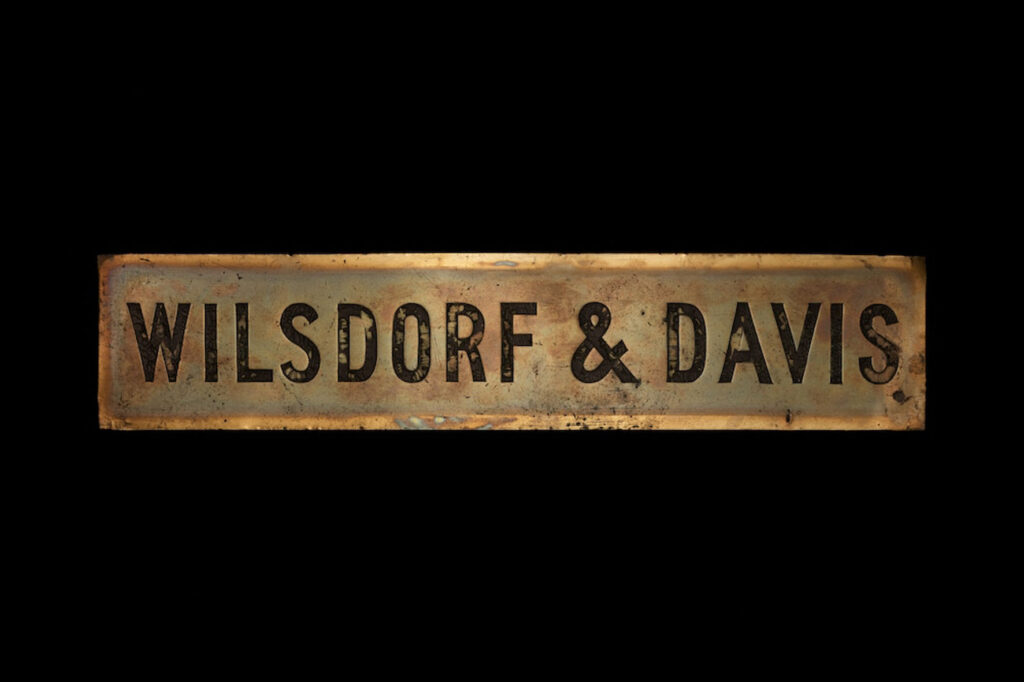
The invention of the name Rolex dates back to 1908 and it’s bizarre that, after all, the word has no real meaning. Wilsdorf wanted a short name, no more than five letters, that could be easily pronounced in all languages and that sounded good, easy to remember, and that could be placed on the dial and the movement in a harmonious way.
The name and the brand began to become known in 1910, when the Bureau Officiel de Contrôle de la Marche des Montres in Bienne, Switzerland, issued the first chronometry certificate ever obtained in the world for this kind of timepiece to a wristwatch of the brand. In 1914, another Rolex received the first “Class A” certificate attributed to a wristwatch, issued by the Kew Observatory in Great Britain, at the time the world’s leading authority on measuring the accuracy of timepieces.
After that of precision, the second challenge won was that of water resistance with the introduction of the Oyster in 1926: the first waterproof wristwatch in the world. Thanks to a patented system of screwed down bezel, case back and winding crown, the case was hermetically sealed and offered the movement the best protection from water.
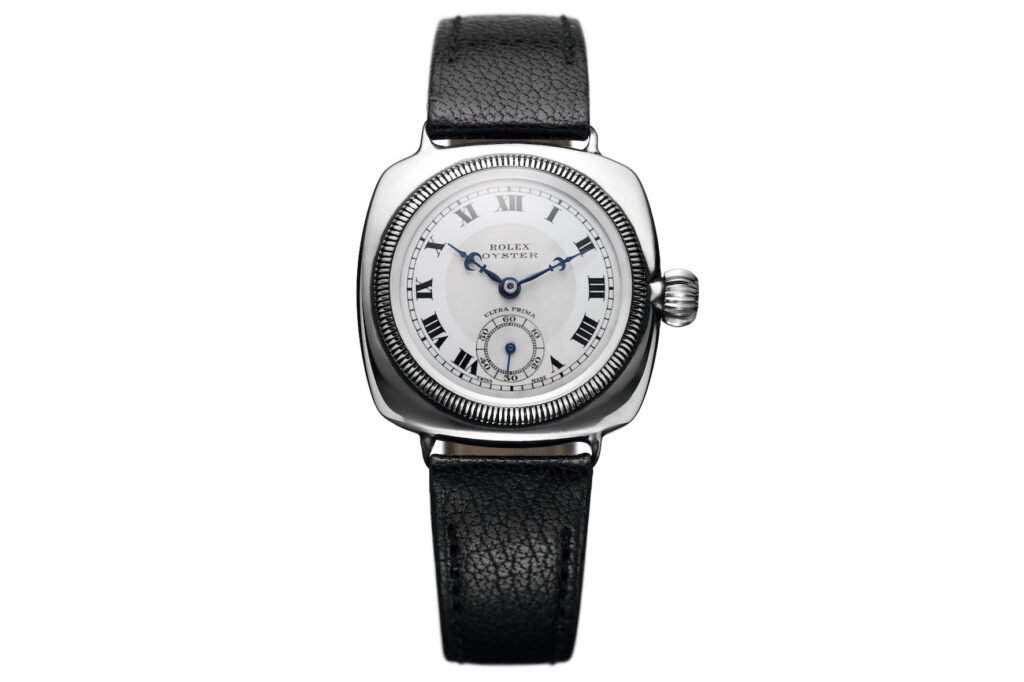
The functional need to guarantee this impermeability introduced two elements that would become the aesthetic signature of Rolex watches: the knurled bezel and the case back groove, which were used to screw the elements onto the case using a specific tool invented by the company.
It was instead in 1931 that they obtained the patent for the Perpetual rotor, which anticipated the modern automatic winding systems. Its halfmoon-shaped mass swung in both directions as the wrist moved, developing kinetic energy transmitted through the gear train of the winding module to the mainspring, which wound itself automatically. In this way it was no longer necessary to wind the watch manually by unscrewing the crown, thus compromising the waterproofness of the timepiece.
In 1931 another patent was filed, one which would have given Rolex its identity, making it the most coveted watch brand: the crown logo. It first appeared on the dial during the 1930s, then on the winding crown in the early 1950s, when it also began to replace the index at 12 o’clock. Since then, it has stood not only for “excellence,” but also for “dream.”
Without delving into the evolution of the company during the 1900s, we think it would be more interesting to finish by recalling the most famous timepieces (without their updates or second generations), with their launch year. It’s a bit like entering the Uffizi or the Louvre museum of watchmaking: we only find masterpieces. Datejust (1945); Day-Date (1956); the six professional watches Explorer and Submariner (1953), GMT-Master (1955), Milgauss (1956), Cosmograph Daytona (1963), Sea-Dweller (1967); Cellini (1968); Yacht-Master (1992); and Sky-Dweller (2012).
ROLEX DAYTONA: THE ORIGIN OF THE NAME
In the midst of all of them, there is the Daytona. A chronograph that over 60 years has become a true icon – a word often used inappropriately, not only in watchmaking, but which perfectly fits Rolex’s masterpiece. And to think that, at the beginning, the word Daytona wasn’t even connected to this chronograph.
For those who don’t know or don’t remember, the beach in Daytona, Florida, was the place chosen between the 1910s and the 1950s to break speed records on motor vehicles. The compactness of the Daytona Beach sand and its straight shape made it an ideal natural track for these challenges. One of the most celebrated racers and record holders in the 1930s, the British Malcolm Campbell, incidentally wore a Rolex while racing.
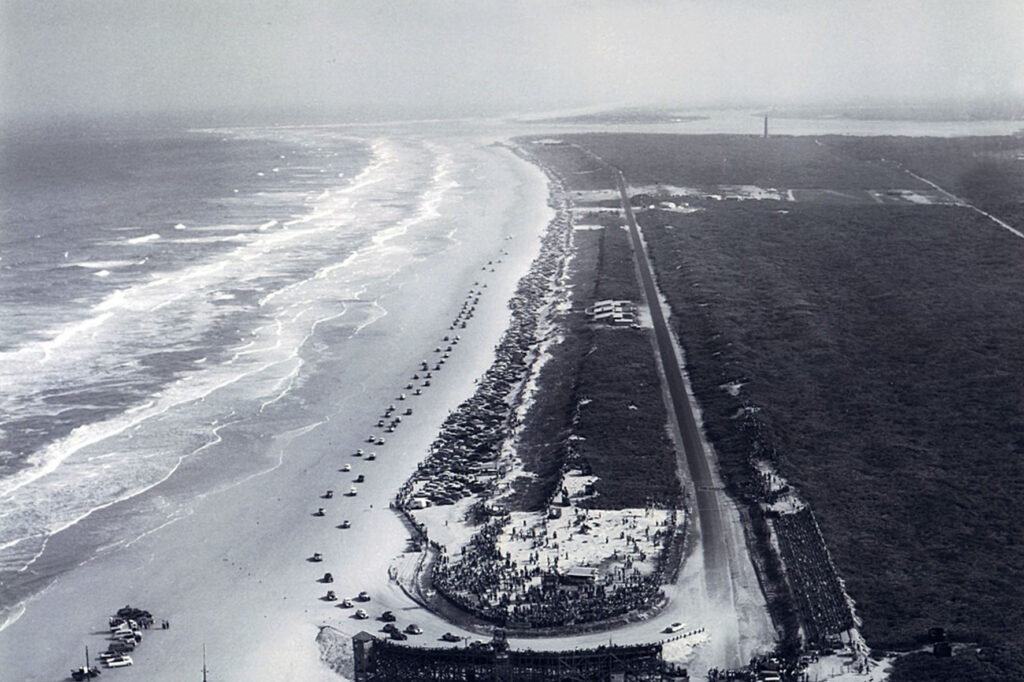
In 1959, the asphalt ring of the Daytona International Speedway was completed, built by William France Sr. who also wore a Rolex, the Zephyr Oyster Perpetual, and appeared in an advertisement for the brand in the early 1960s citing the brand as the official watch of the circuit. After all, since the first editions of the Daytona Continental, the winner of the race was awarded, in addition to the trophy, a Rolex Cosmograph. It was so natural that just one year after the birth of the Cosmograph ref. 6239, in 1964, the Daytona writing began to appear on the dial: placed under the Rolex Cosmograph writing, its size and graphic character were initially smaller. But let’s take a step back.
THE FIRST MAIN REFERENCES
The first Cosmograph reference in 1963 was the 6239, powered by the manual caliber 72B based on Valjoux 72: 18,000 vibrations/hour, micro-star balance wheel with inertial regulation and Breguet hairspring. That watch represented the first time that the tachymeter scale at 300 disappeared from the dial and was moved to the outer bezel. It is estimated that around 14,000 chronographs ref. 6239 where made, 3% of which in gold, the others in steel.
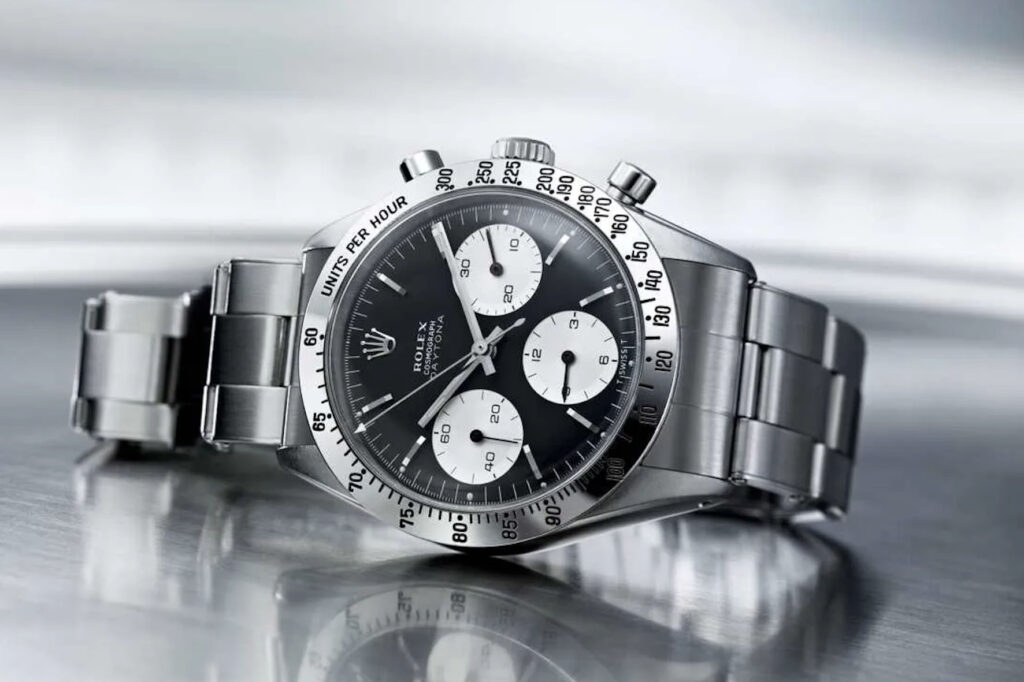
The sporty look was completed by the panda or inverted panda dials, with highly legible counters, designed for timing races. Let’s not forget that the Daytona was born as a professional watch and was targeting professionals. The tachymeter scale on the bezel also met this need.
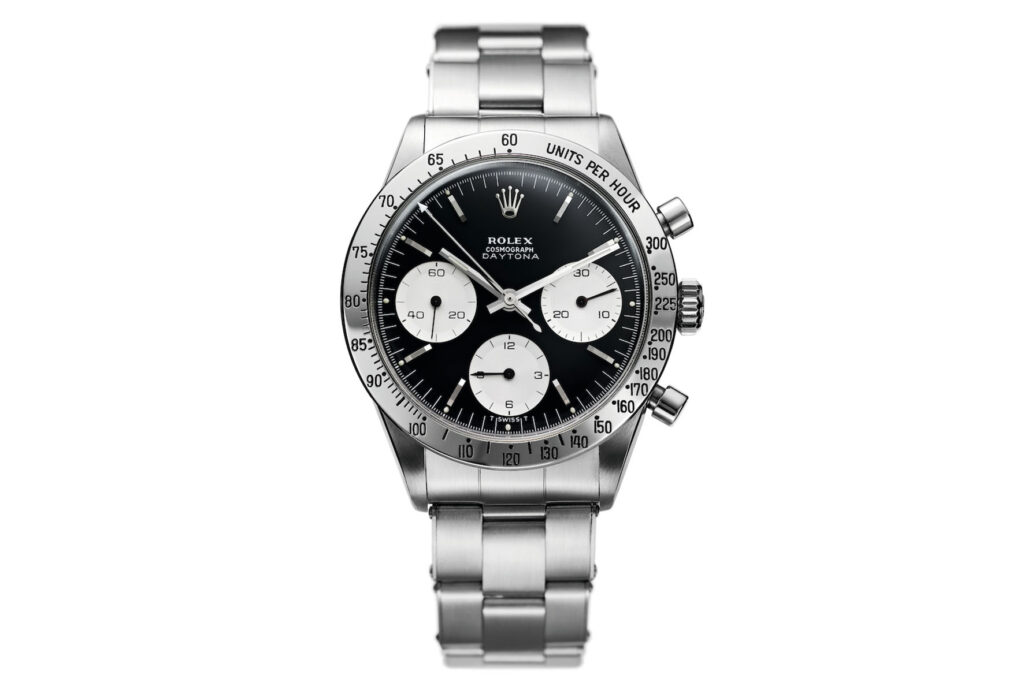
A need that Paul Newman shared: in addition to being a great actor, he was also a good driver. He used to wear a particular version of the Daytona ref. 6239, which became famous bearing his name, characterized by a special dial: the seconds scale was printed around the dial, on a stripe of the same color than the one used for the counters, in contrast with the rest of the dial and, in some cases, with a red gradient. The counters, on the other hand, differed in their square indices which facilitated their reading. Functional rather than aesthetic variations, which improved the legibility of the chronograph during a race.
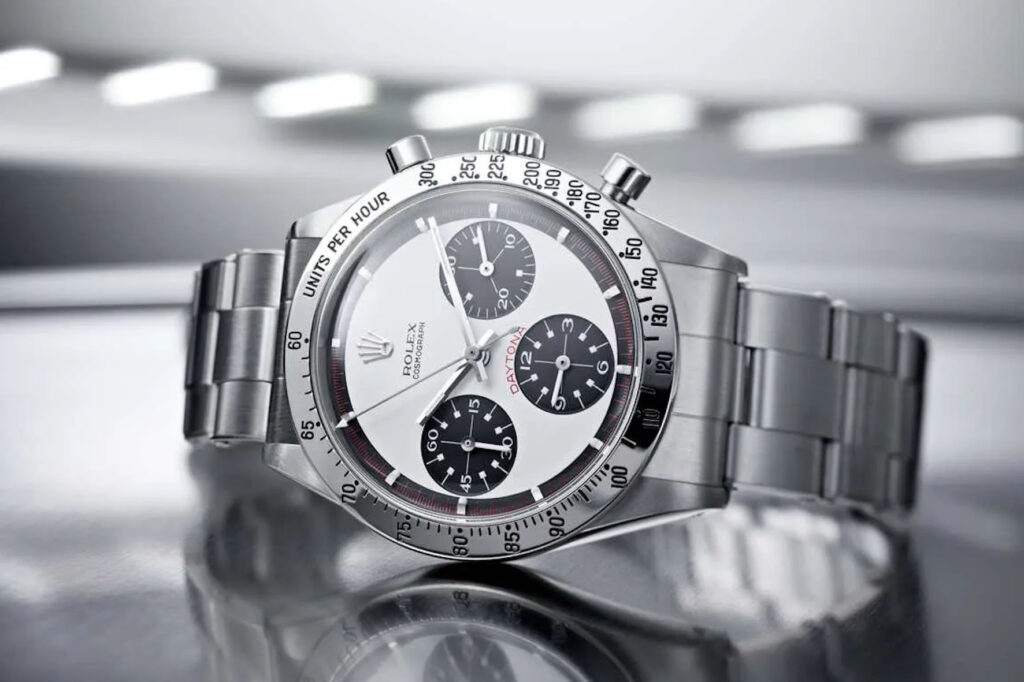
The watch was given to the actor by his wife Joanne Woodward in 1968 while he was filming “Winning,” a story about a race pilot who won the Indianapolis 500. Woodward probably bought it from Tiffany, as the inventory number D61798 engraved on the back of one of the lugs suggests. More significant is the engraving on the case back: “Drive Carefully. Me” – a message from Newman’s wife. We will talk about the importance of this piece in auctions later.
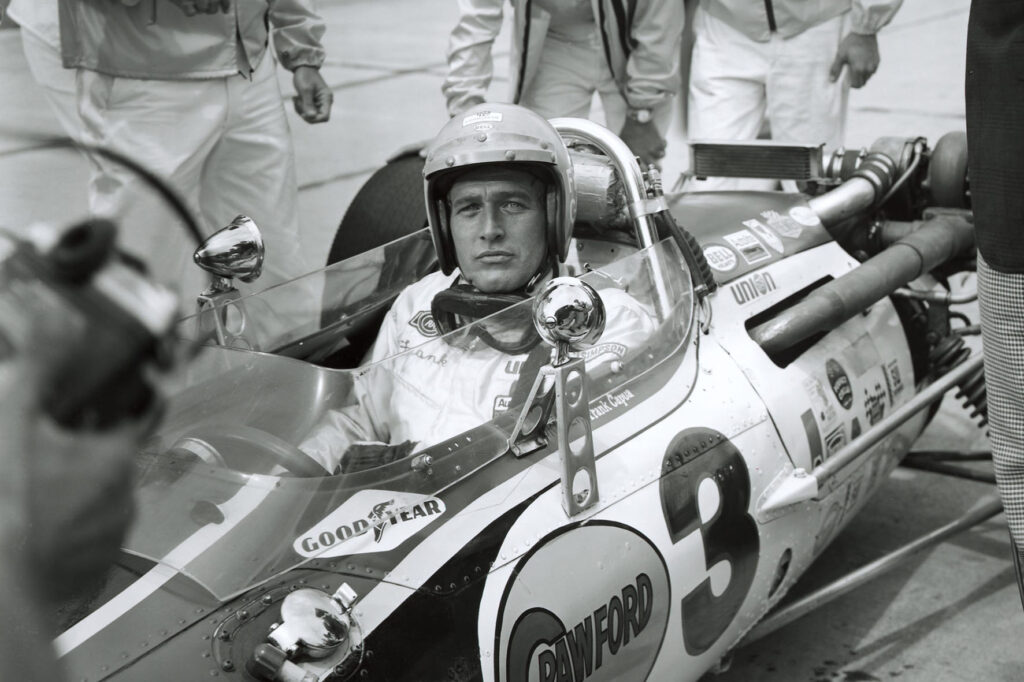
Speaking of functional variations, in 1967 the ref. 6240 – on which the pump pushers were replaced by screw ones – was presented. Beyond aesthetics, their main function was to guarantee the watch greater water resistance. That year, the first Paul Newman dials were produced, bicolor white for the ref. 6240 and tricolor black, with the first Daytona writing in red above the counter at six o’clock. Another novelty was that of the tachymeter bezel with a black Plexiglas disc and a white graduated scale, again with the aim of improving legibility.
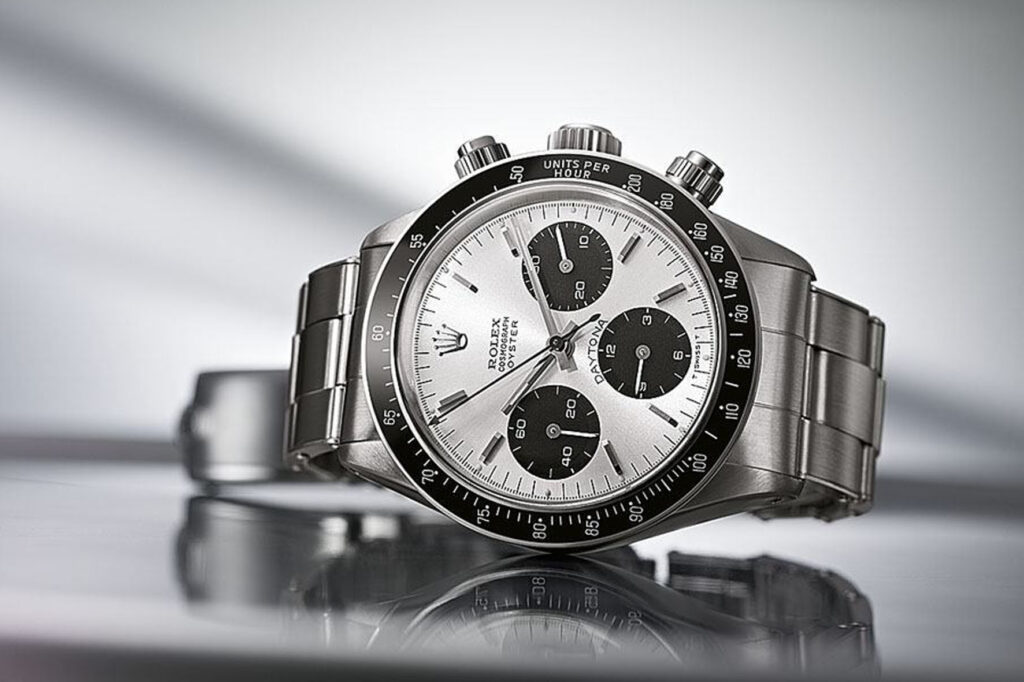
In the following years the ref. 6241, 6263, 6265, 6262, 6264 were produced, presenting various successive improvements: from water resistance to 50 meters; COSC certification; the 701 crown(recognizable by the three spheres embossed under the Rolex logo) or the 703 Triplock; up to the dials with the Daytona writing in red, printed above the counter at six which will equip the steel manual windings until the end of their production. In 1987, the Daytona reached 10 million pieces produced, and Rolex decided to add a letter to the beginning of the numbering. Naturally the first was R, followed by L, E and X, while O was rejected because it was too similar to the number 0.
ROLEX DAYTONA: THE MODERN REFERENCES
1988 was the turning point for the Daytona: with the ref. 16520, presented at Baselworld, the manual winding movement gave way to the automatic. The choice fell on an El Primero base from Zenith, modified by Rolex, who renamed it Caliber 4030.
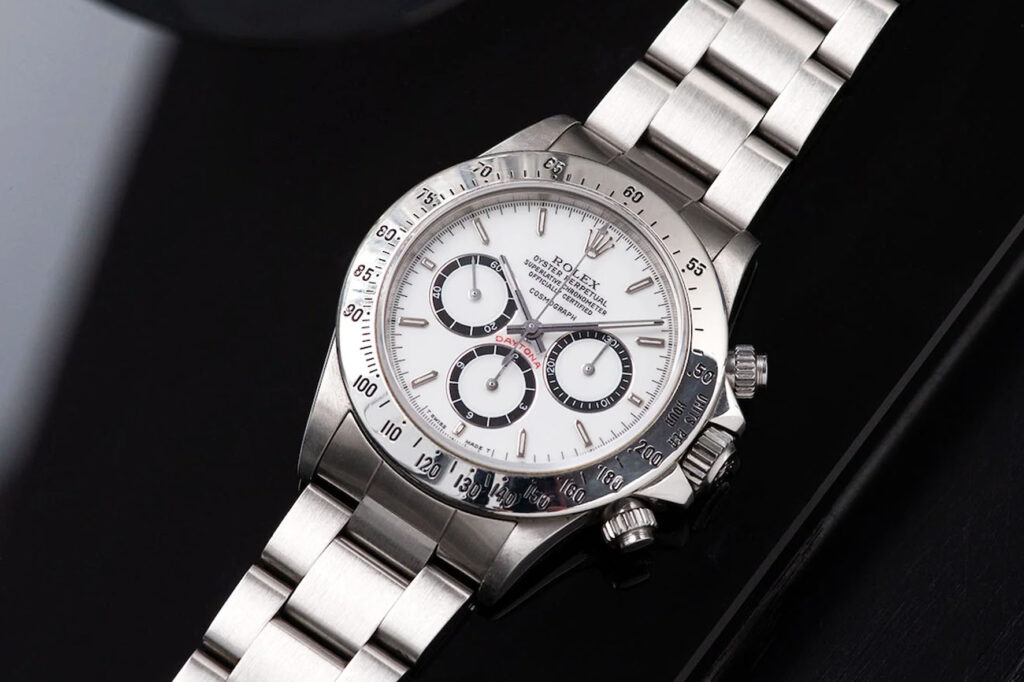
It wasn’t just a matter of updating a caliber, because around 200 elements were modified, more or less 50% of the total, and the interventions were multiple: from increasing the size of the balance wheel to using a Breguet hairspring, up to the use of an oscillating weight similar to the Rolex Perpetual rotor. The most important and well-known difference, however, was the lowering of the oscillation frequency of the balance wheel to 28,800 vibrations/hour, from the 36,000 of the El Primero caliber.
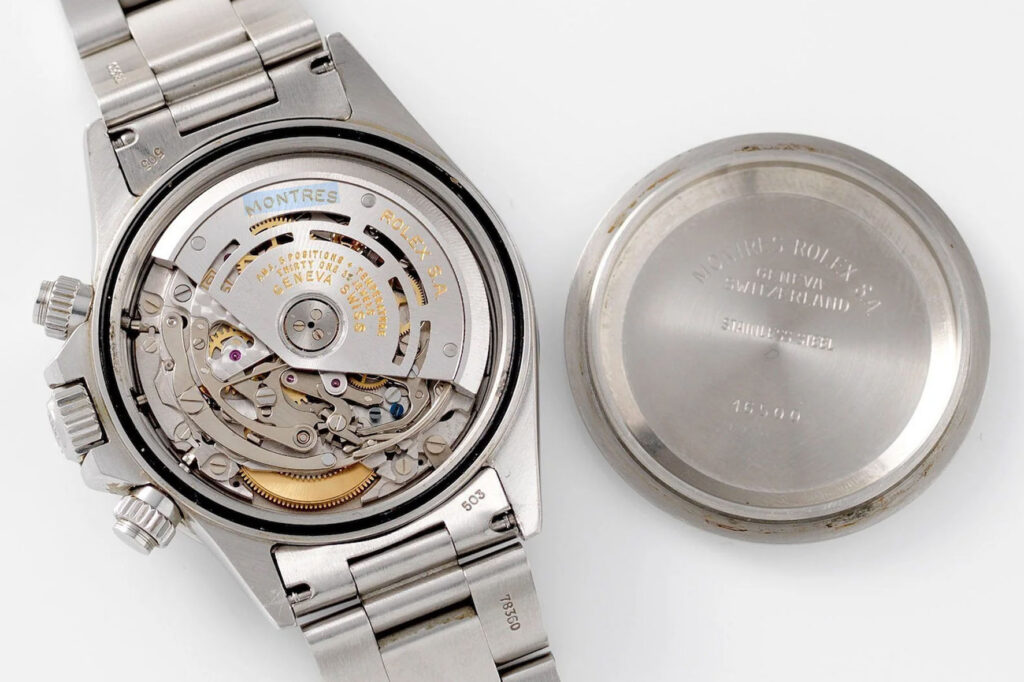
This choice was made to guarantee greater durability to the movement components over time, the wear of which was put to the test by the high frequency, which could however lead to a lower rate precision. These changes to the balance wheel allowed the 4030 caliber to maintain a rate precision similar to that of the El Primero with greater sturdiness and a longer life.
The ref. 16520 was characterized by sapphire crystal, with a generously sized case, which went from 36 to 40 mm, and immediately became a commercial boom. The first models had the bezel engraved at 200, the dial with a white or black background, and the main graphics on five lines – the last of which was slightly distanced from the others. Some early automatic Daytona had a serial number similar to the 1987 production; in fact, the cases were made the year before the presentation of the ref. 16520 in order to get the watch to the dealers immediately after the fair.
Between 1989 and 1990 the Rolex Cosmograph Daytona changed the bezel graphics, first bringing the beginning of the tachymeter scale to 400 units per hour, and then the intermediate to 240, thus arriving at the configuration that we still know today.
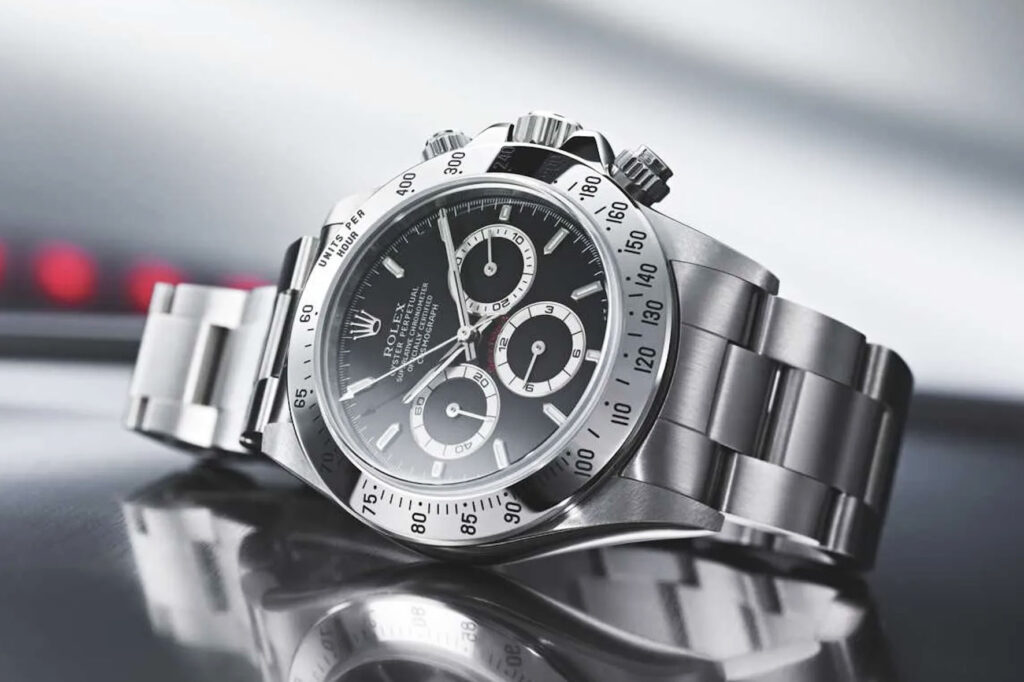
Throughout the 1990s the ref. 16520 was the piece de resistance of the Daytona collection, with different variants and flanked by the more precious ref. 16518 and 16519. The enhancements introduced bit by bit over time brought the ref. 16520 to increasingly become the symbol of Rolex’s industrial and marketing capacity, as well as one of the most coveted and sought-after watches. In 2000 it went out of production, replaced by the 116520. Another revolution, 12 years after the 16520.
THE NEW MOVEMENT: CALIBER 4130
If, from an aesthetic point of view, the new reference was following the traces of the previous one, the real innovations were actually found inside the case. The model was equipped with an automatic chronograph movement of the latest generation, entirely designed and manufactured by Rolex: the caliber 4130. Robust, reliable and precise, it had a vertical clutch to start the chronograph function instead of the classic lateral clutch; the advantages were precise start and stop of the chronograph second hand by pressing the button, and the fact that the chronograph could remain activated for a long time without affecting the accuracy of the watch.
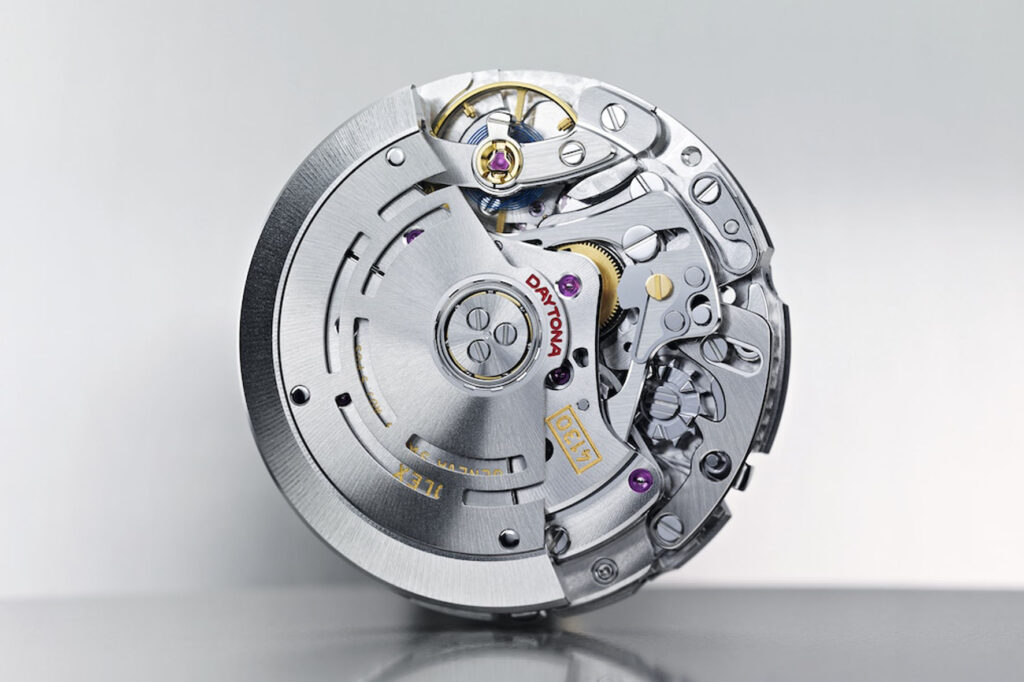
The regulating organ of the caliber 4130 could rely on the Parachrom hairspring, also produced in house. Insensitive to magnetic fields, stable in case of sudden temperature changes and capable of undergoing the thousands of small shocks to which a watch is subjected every day, it always remained up to ten times more precise than a traditional balance-spring watch.
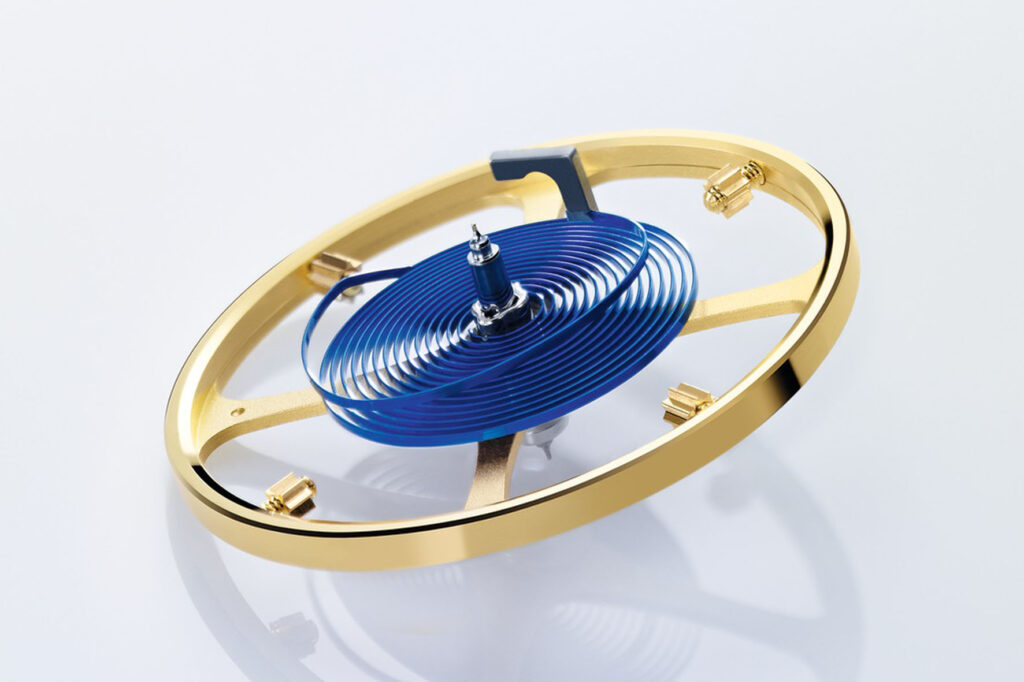
The most competent enthusiasts noticed the presence of the new caliber on the Daytona from some details on the dial of the ref. 116520: the horizontal position of the two chronograph counters, with the small seconds usually located at 9 o’clock now positioned at 6 o’clock, and the fact that the horizontal minute and hour counters were located slightly higher than the center of the dial.
ROLEX AND MATERIAL DRIVEN INNOVATION
In the following years, the history of the Daytona was enriched with very precious references. Among them, the 116519 (white gold with natural meteorite dial), the 166518 (yellow gold with black natural mother-of-pearl dial), the 116598 SACO (leopard-print dial and bracelet and precious stones set on case, bezel and dial), the 116509 (white gold case and bracelet), and the 116505 (Everose gold case and bracelet and solid gold dial).
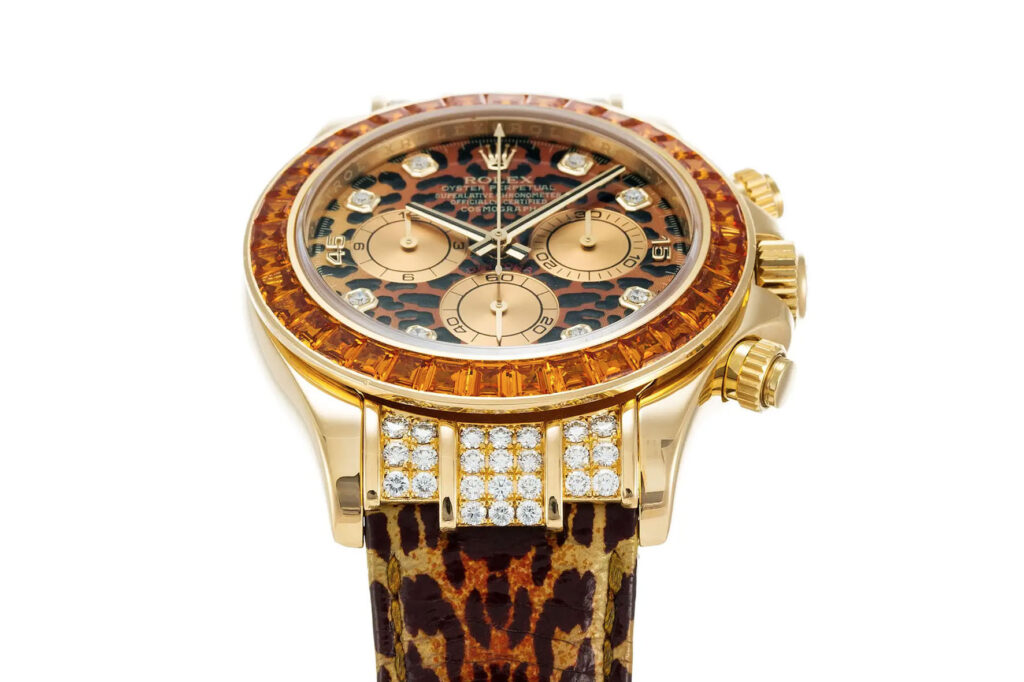
Without forgetting the ref. 116506, the first in platinum presented at Baselworld in 2013 on the occasion of the Daytona’s 50th anniversary: its brown Cerachrom bezel, its ice blue dial and chronograph, and its continuous seconds counters with brown graduated frame still make it irresistible today. A survey carried out by Watchfinder in 2021 – involving over 20,000 collectors and enthusiasts from more than 140 countries – crowned it the “dream watch” par excellence.
The last few years also saw some important innovations in terms of materials and production processes. From 2000, the production cycle of the clasp and that of the bracelet were completely reviewed, moving on to machining from solid and providing eternity to Rolex bracelets – well beyond their estimated lifetime duration. In 2008, the brand presented a watchmaking innovation in luminescence, introducing the Chromalight display on the Deepsea, in a beautiful bright blue color. The oxide-based material is the result of a sensitive and complex manufacturing process, and guarantees a luminescence duration twice that of a standard material, and which on hands, indexes and other display elements can exceed eight hours.
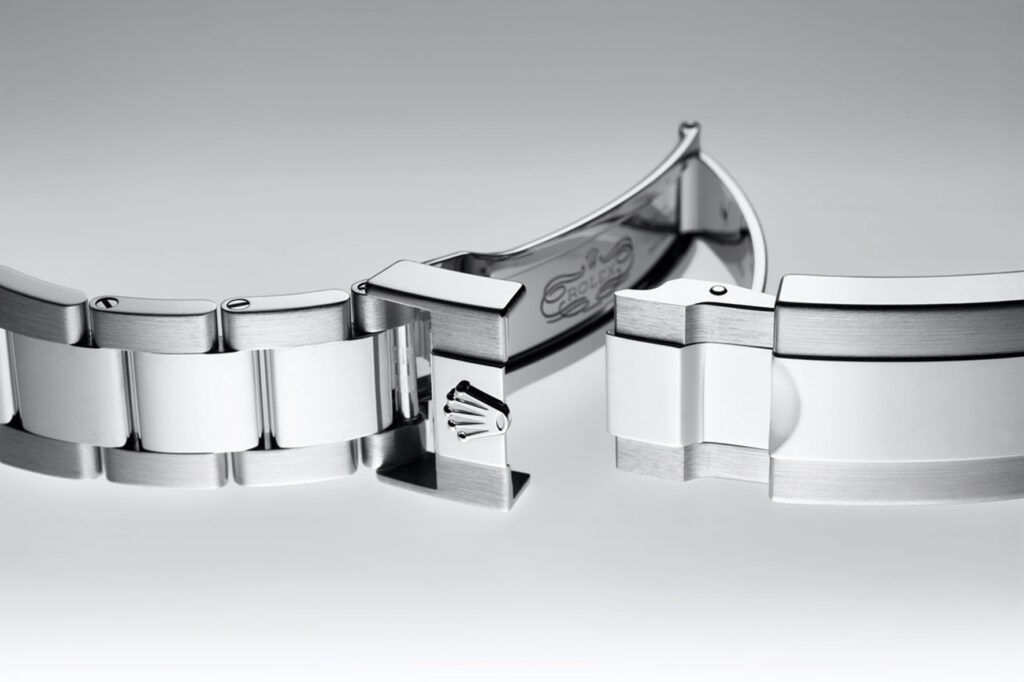
In addition, starting in 2018, Rolex’s specific 904L steel alloy took the name of “Oystersteel”. Generally used in the high technology, space and chemical industries, 904L steels have excellent anti-corrosion properties and are particularly bright when polished. In 1985, Rolex was the first brand to use this steel from the 904L family for its watch cases.
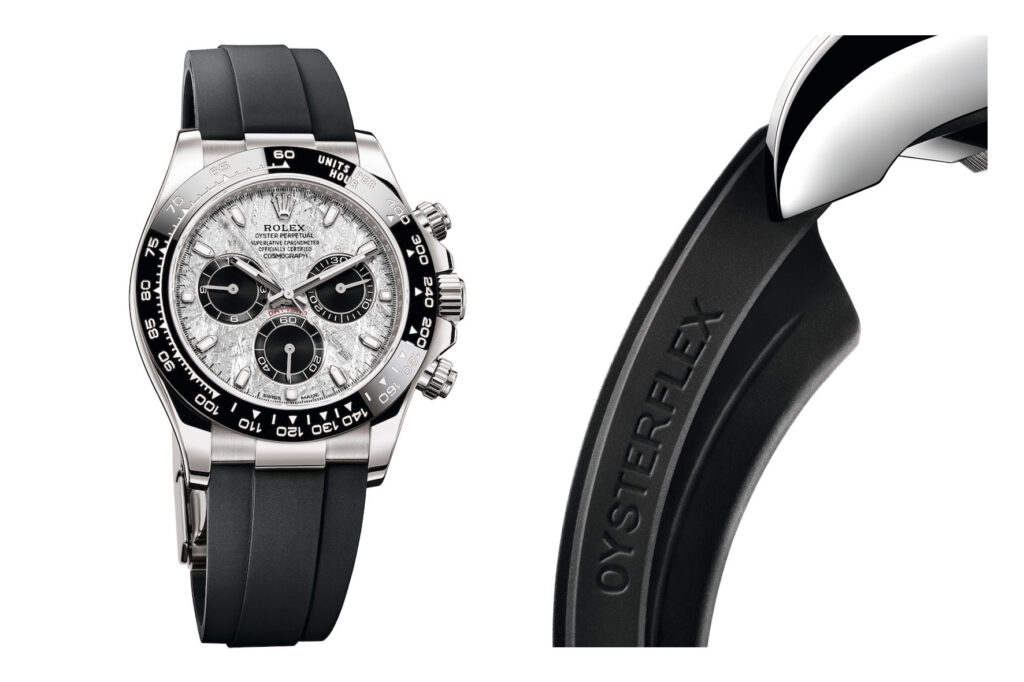
Finally, 2015 sees the introduction on the Oyster Perpetual Yacht-Master of the new Oysterflex bracelet, developed and patented by the brand. It is characterized on the inside by an extremely elastic metal blade, which is then coated with a black high-performance elastomer. The result combines the sturdiness and reliability of a metal bracelet with the aesthetics and flexibility of an elastomer strap. The comfort of the Rolex Oysterflex bracelet is also ensured by the presence, on the internal surface, of lateral “cushions” which stabilize the watch on the wrist.
THE LATEST 2016 VERSION: THE CERAMIC BEZEL
In 2016, the steel Daytona permanently replaced the engraved metal bezel with the monobloc Cerachrom bezel in black ceramic. A reference to the 1965 model, also with a black bezel, but with a Plexiglas disc. Cerachrom is a component patented by Rolex which makes the bezel resistant to scratches and corrosion, with the color remaining unchanged even after exposure to ultraviolet rays.
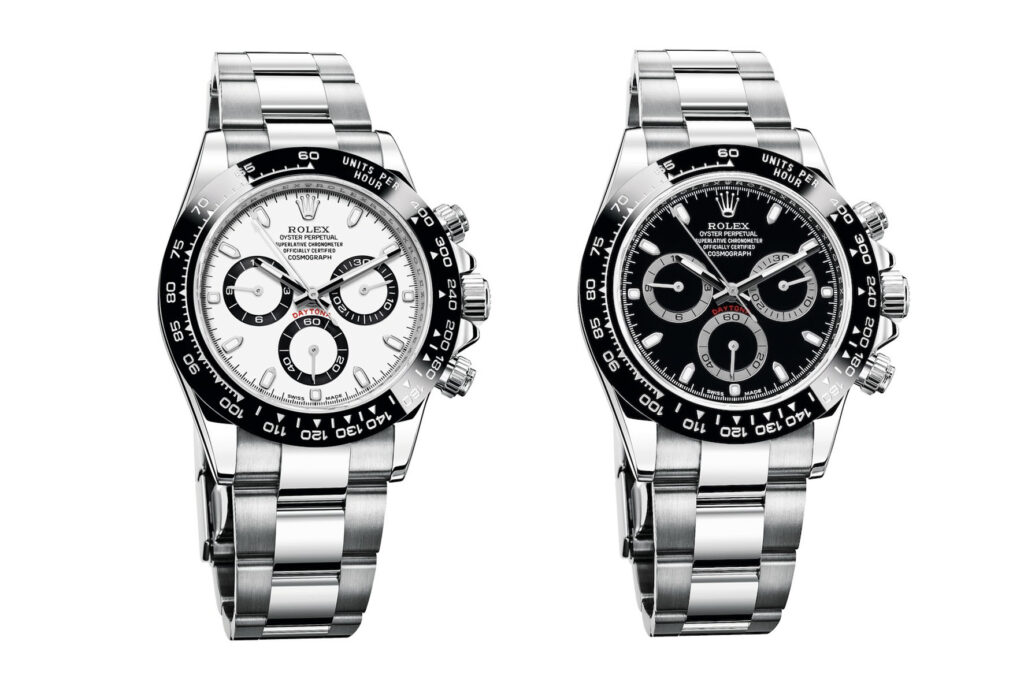
The bezel ensured high legibility, with the graduated scale printed on the ceramic before the firing process and its treatment with a very thin layer of platinum using a PVD (Physical Vapor Deposition) process. The design of the graduated scale has also evolved, with the numbers following the circumference of the bezel and the indexes in the shape of a triangle.
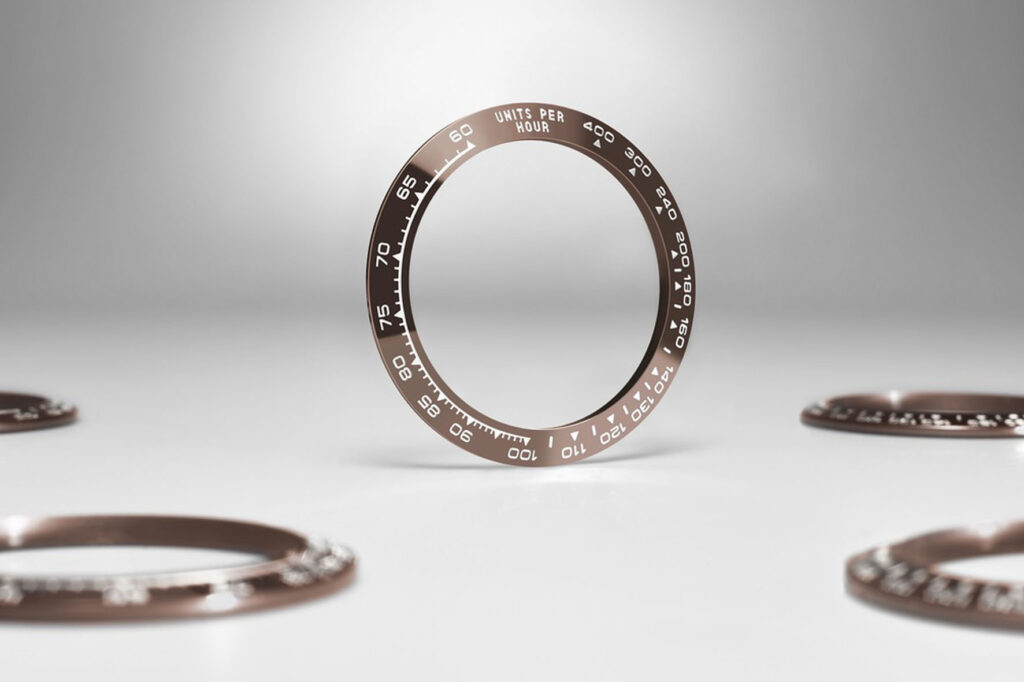
THE DAYTONA IN AUCTIONS
Thanks to such a long and rich history and a vertically growing success especially over the last 25 years, the Daytona has become by far one of the most sought after and quoted watches in the major international auctions. Especially the vintage references record dizzying evaluations, reaching figures never seen before when it comes to references with a special history or a good state of conservation.
The most famous example is that of the Daytona Paul Newman which belonged to the actor, sold by Bacs & Russo in collaboration with Phillips for $17.8 million in October 2017. An extreme case, for what has been unanimously defined as the Holy Grail of watchmaking. The inscription “Drive Carefully. Me” on the case back – where Me is Joanne Woodward, Newman’s wife, the one who gave him the chronograph – made it even more unique, amplifying the myth.
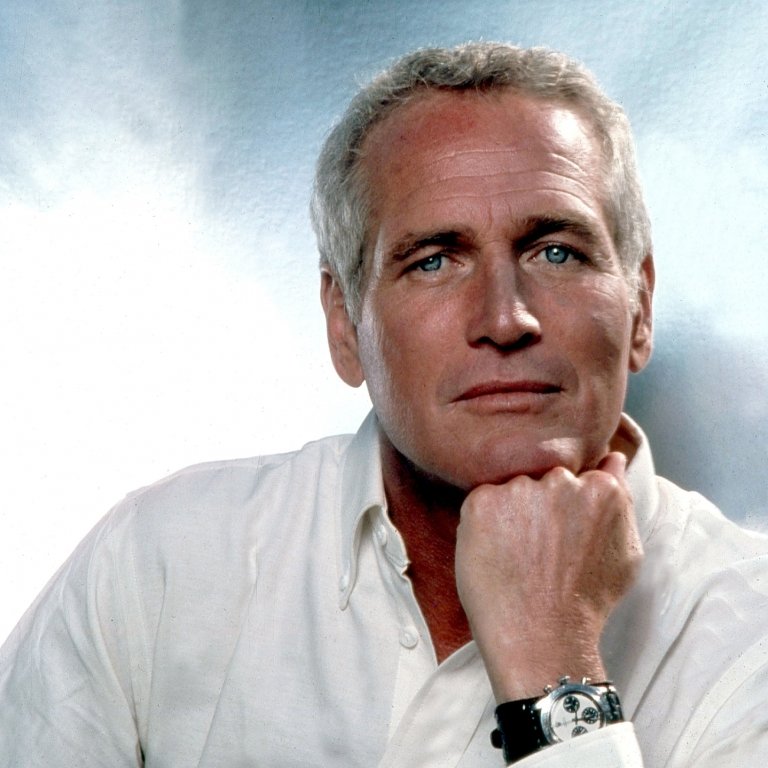
In 2020, it was the turn of another ref. 6263, this time from the 1980s, which belonged to Paul Newman and was given to him again by his wife. It reached a mind-boggling price at Phillips once more: almost 4.5 million euros.
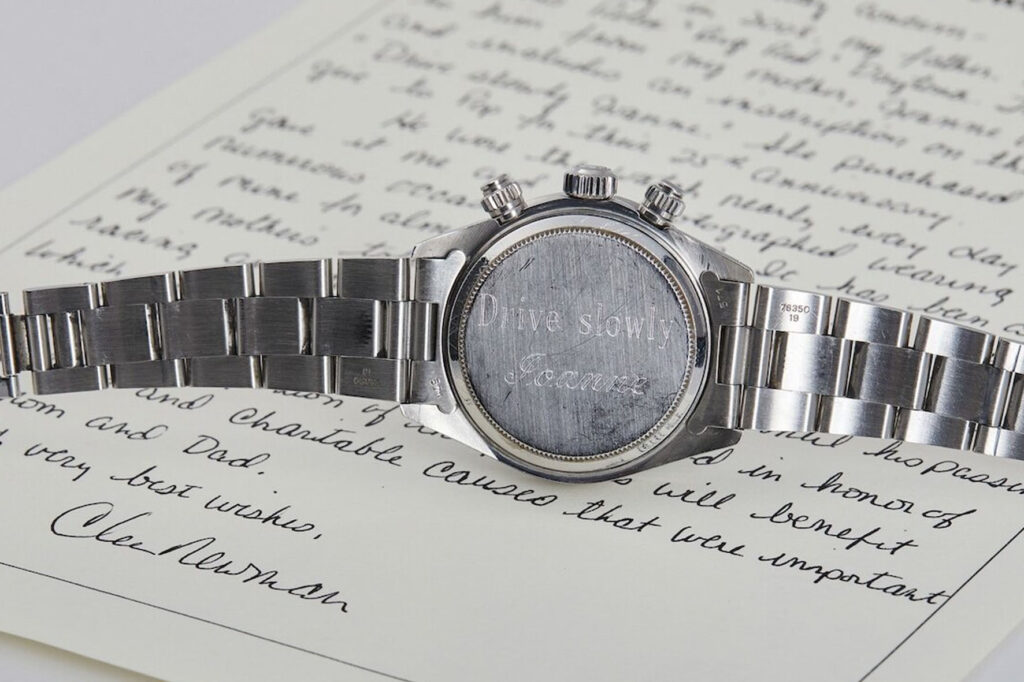
In May 2022, the Daytona was among the protagonists of the Phillips and Christie’s Geneva auctions. Under the hammer of the first there was a rare ref. 6239 nicknamed “Crazy Doc” because of the dial with pulsometric scale. Made in 1968, this reference was chosen as a personal watch by Eric Clapton, and the watch sold last year by Phillips almost reached 1 million and 700 thousand euros.
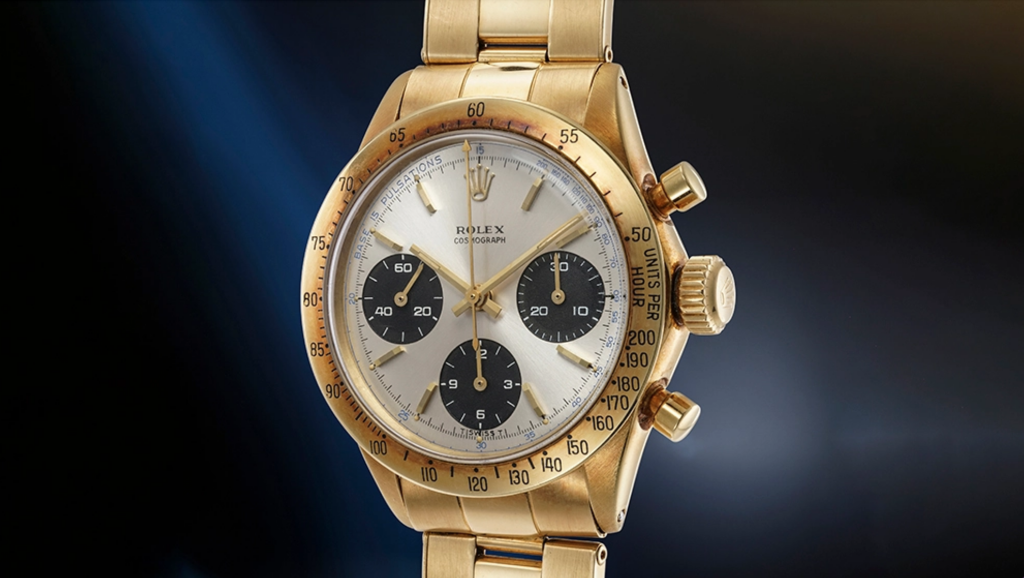
Sotheby’s, on the other hand, auctioned two diametrically opposed references. The first was a 6269 with a gold case and diamond-studded dial and bezel. On the dial there were 240 round diamonds and 9 sapphires in place of the indexes: the final price, almost 1 million and 600 thousand euros. The second was a 6264 Paul Newman, the so-called “Lemon Dial” due to the beautiful yellow gold dial, which in the case of the Daytona showed a brown color near the counters and minute track at auction; a detail that increased the final value to over 1 million and 200 thousand euros.
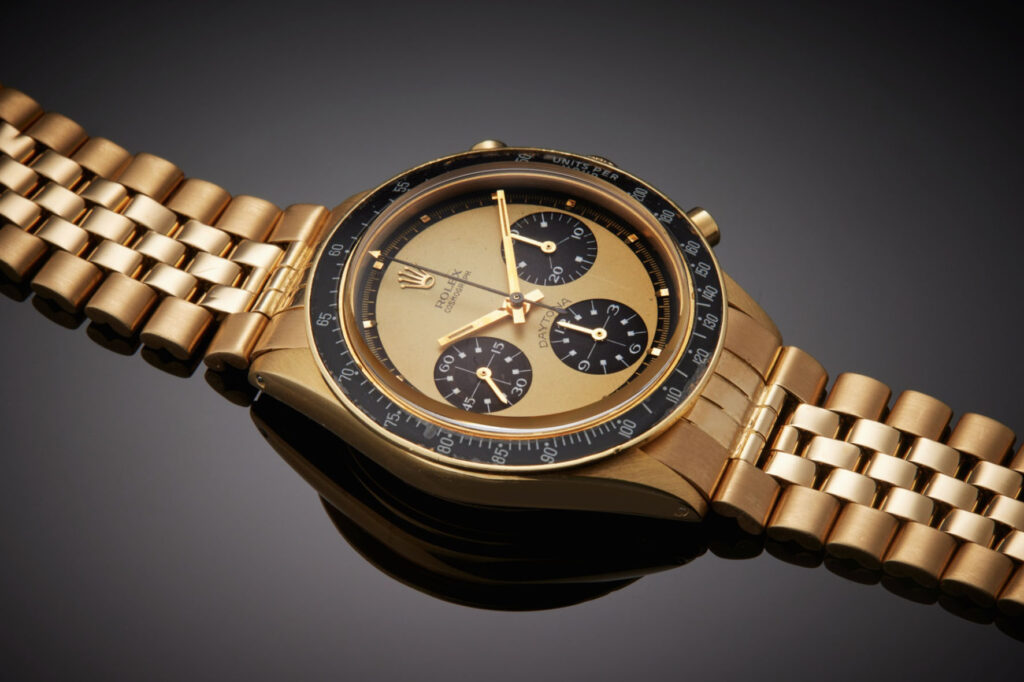
Finally, to get close to the present day, last November a ref. 6263 in yellow gold from around 1969, another “Lemon Dial,” was auctioned by Sotheby’s for 3 million and 400 thousand francs. Again, at Sotheby’s, in December 2022 a Daytona 6262 that Newman had given to his friend Stan Barrett, a Hollywood stuntman, was sold for $378,000.
We recalled only the most striking cases of recent years, but if we wanted to dig into the catalogs of the auction houses, we are sure that we would find several other examples of Daytona that went up for auction even for less showy prices, but of great collectors’ interest. Because when we talk about this chronograph, we are not talking about any watch, but about what for many is THE chronograph, without ifs and buts. Why it has become such, we think we have made it clear by telling its origins, its history, its evolution. Sixty years that made it a legend.
A legend that one of the greatest Italian experts of vintage Rolex, Stefano Mazzariol, will illustrate in exclusivity. Who better than him can unveil all the secrets of the Daytona? Stay tuned!
By Davide Passoni

